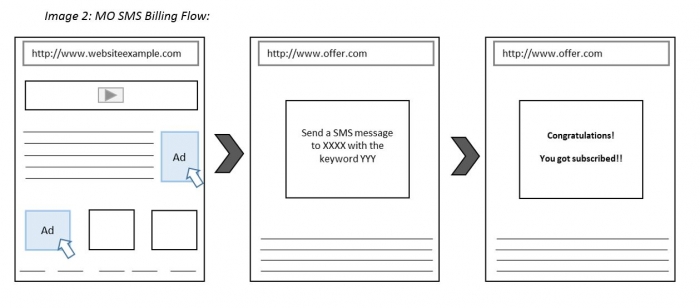Mobile Billing: The Most Popular Offers’ Flow
Last updated on May 16, 2018 by Helena Rosa 5 min readIntroduction
Offers and landing pages don’t all have the same performance.
Indeed, their performance depends on the offer’s flow, country, operator’s requirements, market niche, and even internet connection.
This means that – even in the same country – conversion rates can vary.
In this article, you’ll check what impacts the conversion of different offers.
Moreover, you’ll get to know the most popular offer’s flows.
When users find strategically placed banner ads on a website, they sometimes click them.
Immediately after, the offer displayed will vary according to the billing option activated.
Direct Billing Flow
Some carriers are able to automatically identify the MSISDN (the mobile number which identifies the mobile user.)
This means the billing is made directly.
The money is taken directly from the cellphone balance of a given user.
This flow is usually associated with the 3G connection.
Even so, you must know that it is always determined by the billing system of the carrier.
Another important factor that affects the performance of a direct billing campaign?
The type of opt-in the operator requires!
Check the types of opt-ins you must become acquainted with in the wonderful realm of affiliate marketing!
Single Opt-in
The user needs to confirm only one time that they accept the subscription service.
Simple.
This means that the user arrives to the landing page, clicks on the confirmation button, and then gets subscribed.
Double Opt-in
The user confirms they agree to subscribe to the service.
Then, they have to confirm again.
What happens in this case?
The user answers affirmatively on the webpage.
Then, they’re asked to confirm the subscription to the service for a second time on the landing page or by clicking on a link sent by SMS.
Only after the second confirmation will the user be effectively subscribed.
As a matter of fact, this flow will have a lower conversion rate than the single opt-in.
Explain why, oh remarkable Mobidea Academy writer?
Because the subscription process has one more step.
SMS Billing Flow
For this flow, the user needs to send or insert their mobile phone number in order for the carrier system to identify the MSISDN, as it’s not recognized automatically.
This flow is commonly associated with the Wi-Fi connection.
In the SMS billing flow, some operators require the user to send a message to a specific number (MO) or to receive a pin code by SMS.
Then, the user has to insert the received pin code on the landing page (MT).
Mobile Originated (MO)
Some countries and/or operators only allow the user to be subscribed if they send an SMS message from their mobile phone number.
This is the MO billing system.
This means the SMS message originates in the user’s mobile phone.
In this case, the user arrives to the landing page.
Then, a box pops up.
It usually contains a number that’s normally called LA (large account) or short code.
Then, what?
The user needs to send an SMS message with a keyword.
After the SMS message is sent, the users gets subscribed.
This type of flow is usually associated with one-shot offers, where the user is charged only at the moment they actually send the SMS.
For some advertisers and/or devices, besides the message appearing on the landing page with all the info needed, it can also open the SMS box of the mobile phone of the user, with the keyword and LA already filled.
This is called the Click-to-SMS flow, where the conversion rate is much higher than the traditional MO flow.
Mobile Terminated (MT)
What’s this flow all about?
Easy!
When the user reaches the landing page, the latter shows an empty box for them to insert their mobile phone number.
If the mobile phone number is correct (based on the confirmation from the offers’ provider) the user will receive a pin code in an SMS message for the number they inserted.
When the pin code is confirmed, the user gets subscribed to the offer.
This is the MT flow, which refers to a message that’s sent to a mobile handset.
For this flow, the conversion rate is higher than for MO.
Why?
Because MO basically means the user has to send an SMS message from their mobile phone number.
This obviously means it is clearer that it’s a costly service.
Moreover, the MT flow’s process is easier than the MO’s flow.
These two flows will have different performances on the campaigns.
While the direct billing flow only requires a confirmation to the service, the SMS billing flow implies the user will actually insert their personal information or send an SMS message.
As it’s more obvious to the user that they’ll be charged, the conversion rate for SMS billing is much lower than for the direct billing flow.
The payment for a conversion can also vary.
In fact, it can be CPA or CPI.
CPA is used for subscription services and it means the cost paid by an acquisition, action or conversion, while CPI is the payout for the installation of each app.
Credit Card Billing
For some mobile offers, namely dating products, the billing option is usually made by credit card.
This means the user needs to insert their credit card information in order to create their profile.
Some dating offers are based on subscription services, where the payment is by CPA and the user gets access to private chats.
For this flow, the payout of an offer usually varies:
It can be either CPL or CPS.
CPL or PPL is the cost per lead, where the payment is made as soon as the profile is created on the offer.
CPS or PPS stands for cost per sale.
It comes to be when the user is effectively charged by the service.
For CPS campaigns, the conversion rate will be lower and the payout normally higher.
Why is that?
Because the user may not be willing to give away their personal data.
I’m referring to private things, such as credit card info.
Another reason for a lower conversion rate?
The fact that it’s clearer that the user will be charged.
Conclusion
In fact, there are a lot of possible combinations for an offer flow.
If the conversion process is shorter, the conversion rate of a campaign will be higher.
The same is true for the opposite:
For conversion submissions that are too long, the conversion rate will be lower.
That’s why you can promote an offer for the same vertical and for the same country with performances which are wildly different.
That’s why it’s normal for media buyers to come across completely different payouts in the SAME COUNTRY for different Operators/Carriers!
And all these elements?
Impossible for you to control!
What to do?
You can only be aware of them at all times and manage your campaigns accordingly.
Cheers, bro!

Helena Rosa
Head of Business Development
Helena has been in this industry for 10 years, and that’s why she recognizes a lot of people at events. She joined Mobidea two years ago, starting as an Online Analyst. Now, she’s the Head of Affiliates Support and her team works 7 days per week, covering 2/3 of the world’s many time zones, giving support to all affiliates, no matter the country, the type, the experience… users who are always motivated by their thirst for money! She’s not afraid of fear and loves to challenge herself, because she knows it’s the only way you can learn. For her, one of the best things in life is arriving at a place where you’ve never been before, meeting people you couldn’t even dream existed. Dining out and travelling around the world are Helena’s recipes for happiness!
Why start an Affiliate Marketing business? Find out 5 wicked reasons why you should start earning money in this industry!
Feel like you could learn more about the big differences between advertisers and publishers? This post will make it all very clear for you!
Time for you to finally learn everything you've always wanted to know about Supply-Side Platforms (SSPs) technology!






